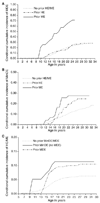Mood episodes and mood disorders: patterns of incidence and conversion in the first three decades of life
- PMID: 19689506
- PMCID: PMC2796427
- DOI: 10.1111/j.1399-5618.2009.00738.x
Mood episodes and mood disorders: patterns of incidence and conversion in the first three decades of life
Abstract
Objectives: Significant questions remain regarding both the incidence patterns of mood episodes in adolescents and young adults from the community and the conversion rate from unipolar to bipolar disorders. We addressed these issues by examining data from a prospective longitudinal community study to (i) determine the cumulative incidence of mood episodes and disorders in the first three decades of life; (ii) determine the risk for first onset of depression among individuals with a previous history of hypomanic/manic episodes and vice versa; and (iii) determine the clinical and treatment characteristics of these subjects.
Methods: Using the Munich-Composite International Diagnostic Interview, clinically trained interviewers assessed mood episodes and mental disorders in 3,021 community subjects (aged 14-24 at baseline and 21-34 at third follow-up).
Results: The estimated cumulative incidence at age 33 was 2.9% for manic, 4.0% for hypomanic, 29.4% for major depressive, and 19.0% for minor depressive episodes; overall, 26.0% had unipolar major depression, 4.0% bipolar depression, 1.5% unipolar mania, and 3.6% unipolar hypomania (no major depression). Overall, 0.6% and 1.8% had unipolar mania or hypomania, respectively, without indication for even minor depression. A total of 3.6% of the initial unipolar major depression cases subsequently developed (hypo)mania, with particularly high rates in adolescent onset depression (< 17 years: 9%). A total of 49.6% of the initial unipolar mania cases subsequently developed major depression and 75.6% major or minor depression. While bipolar cases had more adverse clinical and course depression characteristics and higher treatment rates than unipolar depressed cases, bipolar cases did not significantly differ in mania characteristics from unipolar mania cases.
Conclusions: Unipolar and bipolar mood disorders are more frequent than previously thought in adolescence and young adulthood, a time period when both the recognition and the intervention rates by the healthcare system are rather low. 'Conversion' to bipolar disorder is limited in initial unipolar depression, but common in initial unipolar mania. The remaining unipolar mania cases appear to be significant in terms of clinical and course characteristics and thus require more research attention to replicate these findings.
Conflict of interest statement
The authors of this paper do not have any commercial associations that might pose a conflict of interest in connection with this manuscript.
Figures




Similar articles
-
The mood spectrum in unipolar and bipolar disorder: arguments for a unitary approach.Am J Psychiatry. 2004 Jul;161(7):1264-9. doi: 10.1176/appi.ajp.161.7.1264. Am J Psychiatry. 2004. PMID: 15229060
-
Classifying mood disorders by age-at-onset instead of polarity.Prog Neuropsychopharmacol Biol Psychiatry. 2009 Feb 1;33(1):86-93. doi: 10.1016/j.pnpbp.2008.10.007. Epub 2008 Oct 27. Prog Neuropsychopharmacol Biol Psychiatry. 2009. PMID: 18992784
-
Symptom characteristics of depressive episodes prior to the onset of mania or hypomania.Acta Psychiatr Scand. 2016 Mar;133(3):196-204. doi: 10.1111/acps.12469. Epub 2015 Aug 7. Acta Psychiatr Scand. 2016. PMID: 26252885
-
Bipolar II disorder : epidemiology, diagnosis and management.CNS Drugs. 2007;21(9):727-40. doi: 10.2165/00023210-200721090-00003. CNS Drugs. 2007. PMID: 17696573 Review.
-
ECNP consensus meeting. Bipolar depression. Nice, March 2007.Eur Neuropsychopharmacol. 2008 Jul;18(7):535-49. doi: 10.1016/j.euroneuro.2008.03.003. Epub 2008 May 23. Eur Neuropsychopharmacol. 2008. PMID: 18501566 Review.
Cited by
-
Incorporating Volunteering Into Treatment for Depression Among Adolescents: Developmental and Clinical Considerations.Front Psychol. 2021 May 5;12:642910. doi: 10.3389/fpsyg.2021.642910. eCollection 2021. Front Psychol. 2021. PMID: 34025511 Free PMC article.
-
MicroRNA regulation of prefrontal cortex development and psychiatric risk in adolescence.Semin Cell Dev Biol. 2021 Oct;118:83-91. doi: 10.1016/j.semcdb.2021.04.011. Epub 2021 Apr 28. Semin Cell Dev Biol. 2021. PMID: 33933350 Free PMC article. Review.
-
Toward the Definition of a Bipolar Prodrome: Dimensional Predictors of Bipolar Spectrum Disorders in At-Risk Youths.Am J Psychiatry. 2016 Jul 1;173(7):695-704. doi: 10.1176/appi.ajp.2015.15040414. Epub 2016 Feb 19. Am J Psychiatry. 2016. PMID: 26892940 Free PMC article.
-
Olanzapine approved for the acute treatment of schizophrenia or manic/mixed episodes associated with bipolar I disorder in adolescent patients.Neuropsychiatr Dis Treat. 2010 Nov 10;6:749-66. doi: 10.2147/NDT.S6614. Neuropsychiatr Dis Treat. 2010. PMID: 21127693 Free PMC article.
-
Repetitive Transcranial Magnetic Stimulation for Adolescent Major Depressive Disorder: A Focus on Neurodevelopment.Front Psychiatry. 2021 Apr 13;12:642847. doi: 10.3389/fpsyt.2021.642847. eCollection 2021. Front Psychiatry. 2021. PMID: 33927653 Free PMC article. Review.
References
-
- Harish T, Grover S, Basu D. Recurrent unipolar mania: does it warrant a separate nosological status? German J Psychiatry. 2005;8:8–15.
-
- Goodwin GM, Anderson I, Arango C, et al. ECNP consensus meeting. Bipolar depression. Eur Neuropsychopharmacol. 2008;18:535–549. - PubMed
-
- Kessler RC, Rubinow DR, Holmes C, Abelson JM, Zhao S. The epidemiology of DSM-III-R bipolar I disorder in a general population survey. Psychol Med. 1997;27:1079–1089. - PubMed
-
- Kessler RC, Walters EE. Epidemiology of DSM-III-R major depression and minor depression among adolescents and young adults in the National Comorbidity Survey. Depress Anxiety. 1998;7:3–14. - PubMed

